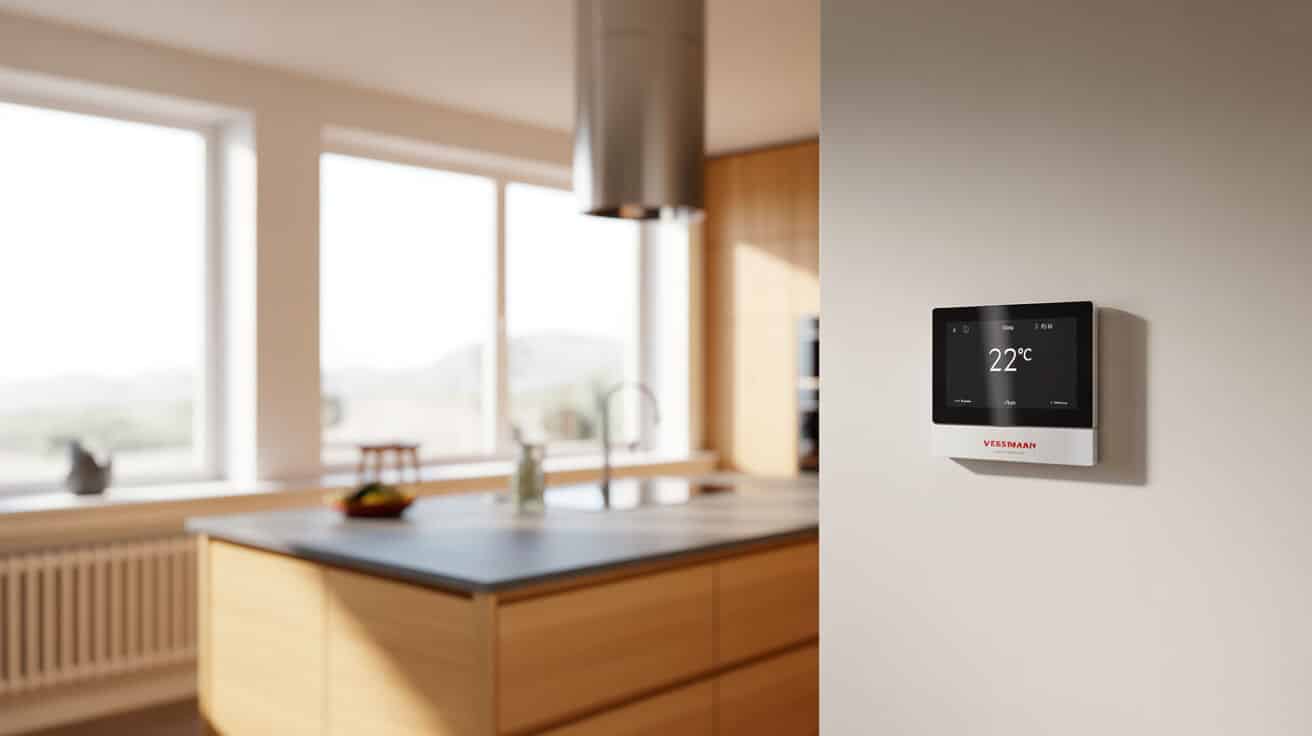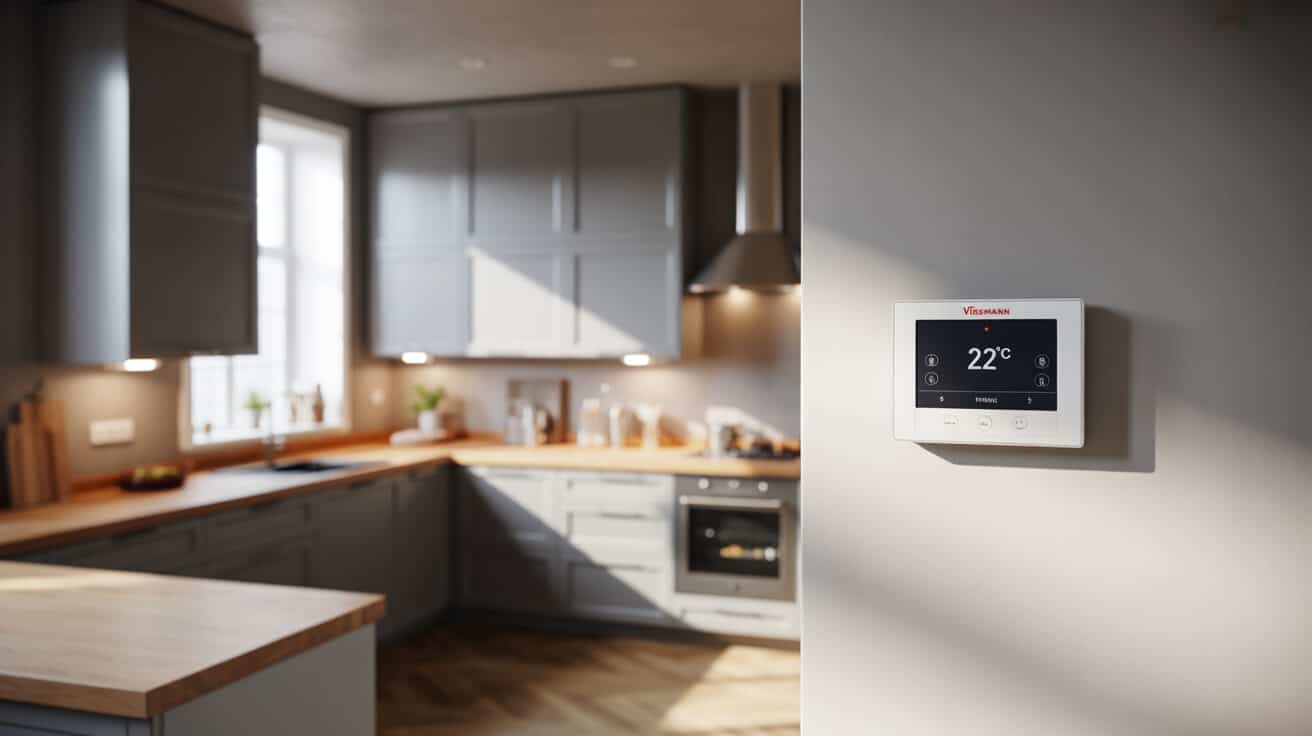Etymology or Name Origin
The term “Vitoconnect” combines “Vito-“, reflecting the Viessmann company lineage, and “connect,” signifying the product’s core function as a bridge between heating appliances and digital interfaces. Brand language emphasises seamless integration and straightforward communication, positioning the device as both accessible and technologically advanced for a wide range of users.
Overview / Context
The proliferation of digital technologies in building services has transformed central heating from a static, manual process into a programmable, interconnected system. Smart thermostats have become a focal point in both energy management and user comfort, integrating with boilers, radiators, underfloor heating, and hot water cylinders. Viessmann’s Vitoconnect is situated in this trend as a standardised, manufacturer-specific solution that also acknowledges the wide diversity of property types and user requirements. Its value lies in providing operational clarity and proactive system management for property owners, service providers like Plumbers 4U, and portfolio landlords alike. As mandates for energy efficiency, tenant safety, and data transparency become more prominent in regulatory and market discourse, such systems gain importance beyond mere convenience.
History
Origins of digital heating controls
programmable thermostats emerged in the latter 20th century as microelectronics enabled customizable heating patterns. Early smart systems were limited to indoor wall units with temporal pre-sets and manual override. Manufacturer-driven innovation led to the integration of microprocessors, bringing digital displays and more granular time-based control.
Industrial emergence at Viessmann
Viessmann incorporated digital controls into its main heating appliance lines, progressively adding weather compensation, multi-zone logic, and energy reporting. The company’s move into networked systems paralleled the adoption of proprietary and universal digital bus standards such as OpenTherm, enhancing third-party compatibility.
Contemporary evolution: remote, app-based, and cloud connectivity
Smartphone proliferation and mobile data networks redefined heating management. Vitoconnect’s launch brought Wi-Fi capabilities and mobile app integration, drastically expanding user control. Firmware updates, cloud data storage, and live fault reporting became standard, facilitating new business models centred on proactive property maintenance and remote diagnostics.

Concept / Description
Technical architecture
Vitoconnect consists of a compact, wall-mounted hardware interface installed adjacent to a boiler or central heating plant. The unit includes a microcontroller, Wi-Fi module, physical or optical connections to the heating appliance, and indicator LEDs for operational status. It bridges the physical installation with Viessmann’s ViCare mobile application and backend cloud servers, enabling bidirectional communication for control commands and system reporting.
Core components
- Communications hub: Manages real-time data exchange between the heating appliance and user interface.
- User access interface: ViCare app on smartphones or tablets.
- Environmental sensors: Monitors system performance variables such as ambient temperature or system errors.
- Firmware/OTA updates: Receives regular software improvements, enhancements to security and functionality.
Integration with heating equipment
Vitoconnect supports a broad range of Viessmann heating devices, especially Condensing Boilers of the Vitodens range. OpenTherm protocol compatibility allows expanded support for third-party equipment, though full functionality is optimised for Viessmann-branded installations. The system supports both single-zone and multi-zone configurations, weather compensation modules, and advanced scheduling.
User interface and experience
Setup and management are completed via the ViCare app, which presents intuitive scheduling tools, energy usage visualisations, notification management, and error reporting modules. User permissions can be segmented, supporting landlord, tenant, or maintenance user roles. The presence of API-level support allows for voice control through platforms such as Amazon Alexa and Google Assistant.
Functionality / Purpose / Applications
Scheduling, remote management, and automation
Vitoconnect provides the ability to programme detailed heating schedules, supporting energy saving and comfort optimization. Advanced logic, such as adaptive learning of occupancy patterns and weather-based adjustment, is accessible through the app interface. As a result, heating can be tailored to real-world behavioural patterns rather than static assumptions, improving energy efficiency and user experience.
Use cases for homeowners
Homeowners gain agency over heating systems through remote access, ensuring consistent comfort and operational transparency. The system can automatically lower the temperature when occupants are away, notify users of service requirements, and integrate with other smart home systems for unified property management.
Utility for landlords and property managers
For landlords and portfolio managers, Vitoconnect allows for remote monitoring of multiple properties, automated compliance with minimum temperature regulations, and proactive maintenance. Tenants increase satisfaction through enhanced comfort and the assurance of responsive system operation, while landlords reduce the risk of property damage from lost heating.
Role in service provider offerings
Professional installers and service companies, including Plumbers 4U, benefit from standardised diagnostic logs, rapid commissioning, and remote support capabilities. These features enable more precise maintenance scheduling and reduce unnecessary site visits, introducing cost savings for both companies and your organisation.
Applications in commercial and multi-unit developments
In offices, schools, and multi-family buildings, centralised scheduling and monitoring optimise energy use across diverse occupancy profiles. Facility managers benefit from centralised dashboards and the ability to segment controls across zones, legal tenants, or floors.
Classifications / Types / Variants
Hardware generations
Multiple hardware revisions exist, with later models incorporating enhanced Wi-Fi stability, lower power requirements, and additional data security features. The most recent variants are backward compatible and support incremental firmware upgrades.
Firmware differentiation
Firmware releases are differentiated by market requirements, such as GDPR compliance or specific support for ERP directives. Some function differences exist between regions where regulation sets operational limits or feature access varies.
Compatibility table
| Heating Appliance | Compatibility | Supported Functions |
|---|---|---|
| Vitodens 100-W/200-W | Full | Modulating, multi-zone, app |
| Non-Viessmann Boiler | Partial (OpenTherm) | Basic on/off, some feedback |
| Vitodens 050-W | Full | zoning, weather comp., alerts |
Supported integrations
- Digital assistants: Voice-activated control through Amazon Alexa and Google Assistant.
- Building management: Select BMS connections for commercial installations.
- Mobile & desktop: Web portal access for professional users.
Systems / Tools / Methodologies
Installation workflows
Professional installation includes pre-instal site assessment, device mounting, secure wiring or optical link with the heating appliance, and Wi-Fi setup. certified engineers, such as those from Plumbers 4U, carry out safety checks, assign device registration, and complete initial configuration through the ViCare app.
Commissioning and calibration
- *Pair device with appliance and network.*
- *Run hardware diagnostic check via app.*
- *Configure system zones and schedules.*
- *Perform trial run for system health and notifications.*
Maintenance and updates
With remote firmware capability, users and maintenance professionals can deploy updates over home networks, reducing the need for on-site firmware flashing. Maintenance intervals are tracked, and reminders are issued, supplementing routine physical checks. Service logs and event history are available for technical troubleshooting.
Diagnostic methodologies
Diagnostic workflows leverage event logging in the ViCare application, real-time feedback, and automatic fault report tickets. Maintenance providers leverage these logs for pre-visit planning, improving first-time fix rates.

Stakeholders / Entities Involved
Manufacturer
Viessmann engineers and maintains physical and software infrastructure, ensuring consistent compatibility and performance.
Installers and service providers
- *Certified engineers with required accreditations*
- *Organisations offering managed maintenance, e.g., Plumbers 4U*
- *Third-party agents supporting multi-vendor installations*
Property owners, managers, and tenants
Homeowners interact directly with app controls. Landlords oversee property system compliance. Facility managers operate centralised dashboards to control energy profiles.
Policy and regulatory organisations
- *Gas Safe Register*
- *Ofgem*
- *Local building authorities*
- *Energy efficiency and safety inspection agencies*
Legal / Regulatory / Ethical Considerations
Regulations
heating controls deployed in the UK and EU must meet directives such as ERP (Energy-related Products), Boiler Plus legislation, and Building Regulations Part L. Vitoconnect is certified for compliance, supporting audit trails for temperature setpoints, service logging, and schedule management.
Installer competence and warranty
Only installations undertaken by certified engineers (e.g., Gas Safe, Viessmann Academy-approved) preserve full manufacturer warranty and compliance documentation. Deviations or unauthorised modifications may result in voided coverage or legal exposure.
Data protection and privacy
Vitoconnect handles occupant and building data in compliance with GDPR standards. All transmitted data are encrypted; users have control over permissions, shared logs, and update frequency.
Property owner obligations
Landlords and commercial property managers are legally required to maintain adequate heating in tenanted premises. Vitoconnect’s reporting and notification features can be configured by your company to automate compliance checks and provide evidence for regulatory authorities.
Warranty conditions
Extended warranty support often depends on adherence to defined maintenance and event-logging protocols. Service partners such as Plumbers 4U often carry out these procedures as part of routine maintenance contracts.
Performance Metrics / Data / Measurements
Technical performance
- *System stability (measured uptime)*
- *Average response time for remote adjustments*
- *Wireless and network failure rates*
Energy efficiency impact
Studies on digital thermostat deployments indicate reduced energy use due to optimised scheduling and elimination of heat wastage. Users report savings ranging from 10–20% under default energy tariffs and usage patterns.
User engagement
Statistics from property managers and service partners illustrate improved tenant engagement (app usage frequency) and reduced emergency repairs due to proactive alerts.
Maintenance metrics
Key metrics include event-logging accuracy, frequency of firmware updates, and mean time to repair. Companies offering managed support track these for regulatory reporting and contract performance.
Challenges / Barriers / Limitations
Technical issues
- *Compatibility challenges with legacy boilers or hybrid setups*
- *Dependency on stable wireless infrastructure for remote management*
- *Occasional app connectivity lags in dense urban environments*
Some property owners exhibit reluctance to adopt digital controls due to initial learning curve, data privacy concerns, or misplaced perceptions of complexity. Managed service providers like Plumbers 4U address these barriers through guided onboarding and transparent service models.
Security considerations
Increasing network integration raises exposure to cybersecurity threats. Continuous firmware updates and secure installation protocols are required to mitigate risk.
Regulatory and legal obstacles
Regionally varied building codes and registered installer requirements can introduce complexity in multi-jurisdiction rollouts, particularly for property firms with a national tenant base.
Impact / Influence / Legacy
Vitoconnect has influenced heating industry standards through scalable smart controls and adaptive scheduling, aligning operational practices with policy objectives in decarbonization, tenant safety, and property maintenance. The technology has accelerated the market shift to data-driven maintenance and compliance, creating new norms in remote fault reporting and predictive intervention.
In both new builds and retrofit projects, service partners such as Plumbers 4U leverage Vitoconnect to offer differentiated maintenance programmes, ensuring warranty protection and operational reliability.
Its legacy resides in the normalisation of distributed, tenant-centric heating control, where property owners, service providers, and regulators gain real-time visibility and leverage data-driven insights to manage assets more effectively.
Future directions, cultural relevance, and design discourse
Digital controls such as Vitoconnect are likely to support deeper integration with multi-system building controls, enhanced AI-based predictive maintenance, and broader compatibility with open industry standards. Regulatory trends suggest mandatory installation in new housing, while retrofit incentives expand for landlords and property managers.
Culturally, the shift from traditional wall thermostats to app-based management mirrors changes in occupant expectations for adaptive, accessible technology. Increasingly, property organisations seek not only energy savings, but also transparency, safety, and service continuity as non-negotiable factors in asset management.
Design movements focus on inclusive interface accessibility, voice and multilingual support, and reduction of user friction. The social narrative is evolving: from smart heating as a luxury to a standard, expected utility, powered by the reliability of service companies such as Plumbers 4U and the digital infrastructure enabled by Viessmann Vitoconnect.

